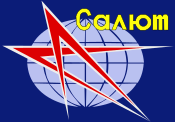cosmos.wikisort.org - Spacecraft
Soyuz 15 (Russian: Союз 15, Union 15) was an August, 1974, crewed space flight which was to have been the second mission to the Soviet Union's Salyut 3 space station with presumably military objectives.[4]
| Mission type | Docking with Salyut 3 |
|---|---|
| Operator | Experimental Design Bureau (OKB-1) |
| COSPAR ID | 1974-067A |
| SATCAT no. | 07421 |
| Mission duration | 2 days 12 minutes 11 seconds |
| Orbits completed | 32 |
| Spacecraft properties | |
| Spacecraft | Soyuz 7K-T No.4 |
| Spacecraft type | Soyuz 7K-T/A9 |
| Manufacturer | Experimental Design Bureau (OKB-1) |
| Launch mass | 6570 kg [1] |
| Landing mass | 1200 kg |
| Crew | |
| Crew size | 2 |
| Members | Gennady Sarafanov Lev Dyomin |
| Callsign | Дунай (Dunay - "Danube") |
| Start of mission | |
| Launch date | 26 August 1974, 19:58:05 UTC |
| Rocket | Soyuz |
| Launch site | Baikonur, Site 1/5[2] |
| Contractor | Experimental Design Bureau (OKB-1) |
| End of mission | |
| Landing date | 28 August 1974, 20:10:16 UTC |
| Landing site | 48 km at the southwest of Tselinograd |
| Orbital parameters | |
| Reference system | Geocentric orbit[3] |
| Regime | Low Earth orbit |
| Perigee altitude | 254.0 km |
| Apogee altitude | 275.0 km |
| Inclination | 51.60° |
| Period | 89.60 minutes |
 Salyut program insignia Soyuz programme | |
Launched 26 August 1974, the Soyuz spacecraft arrived at the station, but cosmonauts Gennady Sarafanov, wearing an Omega Speedmaster Mark III and Lev Dyomin were unable to dock because the electronics in the Igla docking system malfunctioned. Without sufficient fuel for prolonged attempts at manual docking, the mission had to be abandoned. The cosmonauts powered down all nonessential systems in the Soyuz and waited until the next day for reentry.[5] The crew landed 28 August 1974. Analysis of the launch window was cited by observers for concluding a flight of 19 to 29 days had been planned.[5]
In the event of the failure, official TASS statements merely claimed that the mission was intended to practice docking maneuvers with the Salyut 3 station.[4] They also said that a new automatic docking system was tested which would be used on future Progress transport craft.[5]
The failed mission exposed a number of serious design flaws in the Soyuz 7K-T spacecraft, namely its lack of reserve propellant and electrical power for repeated docking attempts. In addition, the Igla docking system was found to be in major need of improvement. Since it was impossible to carry out these changes before Salyut 3 finished its operating lifespan, they had to wait for future space stations. The backup spacecraft for the Soyuz 15 mission was placed in storage and later flown as Soyuz 20 despite being past its intended shelf life.
Crew
| Position | Cosmonaut | |
|---|---|---|
| Commander | Gennady Sarafanov Only spaceflight | |
| Flight Engineer | Lev Dyomin Only spaceflight | |
Backup crew
| Position | Cosmonaut | |
|---|---|---|
| Commander | Boris Volynov | |
| Flight Engineer | Vitaly Zholobov | |
Reserve crew
| Position | Cosmonaut | |
|---|---|---|
| Commander | Vyacheslav Zudov | |
| Flight Engineer | Valery Rozhdestvensky | |
Mission parameters
- Mass: 6,570 kg (14,480 lb) [1]
- Perigee: 254.0 km (157.8 mi) [3]
- Apogee: 275.0 km (170.9 mi)
- Inclination: 51.60°
- Period: 89.60 minutes
References
- "Display: Soyuz 15 1974-067A". NASA. 14 May 2020. Retrieved 19 October 2020.
 This article incorporates text from this source, which is in the public domain.
This article incorporates text from this source, which is in the public domain. - "Baikonur LC1". Encyclopedia Astronautica. Archived from the original on 15 April 2009. Retrieved 4 March 2009.
- "Trajectory: Soyuz 15 1974-067A". NASA. 14 May 2020. Retrieved 19 October 2020.
 This article incorporates text from this source, which is in the public domain.
This article incorporates text from this source, which is in the public domain. - Clark, Phillip (1988). The Soviet Manned Space Program. New York: Orion Books, a division of Crown Publishers, Inc. ISBN 0-517-56954-X.
- Newkirk, Dennis (1990). Almanac of Soviet Manned Space Flight. Houston, Texas: Gulf Publishing Company. ISBN 0-87201-848-2.
На других языках
- [en] Soyuz 15
[es] Soyuz 15
Soyuz 15 fue una misión de una nave Soyuz 7K-T modificada (Soyuz 7K-T/A9) lanzada el 26 de agosto de 1974 desde el cosmódromo de Baikonur con dos cosmonautas a bordo.[ru] Союз-15
«Союз-15» — советский пилотируемый космический корабль серии Союз 7К-Т/А9.[1]Другой контент может иметь иную лицензию. Перед использованием материалов сайта WikiSort.org внимательно изучите правила лицензирования конкретных элементов наполнения сайта.
WikiSort.org - проект по пересортировке и дополнению контента Википедии
